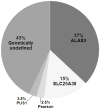Systematic molecular genetic analysis of congenital sideroblastic anemia: evidence for genetic heterogeneity and identification of novel mutations
- PMID: 19731322
- PMCID: PMC2843911
- DOI: 10.1002/pbc.22244
Systematic molecular genetic analysis of congenital sideroblastic anemia: evidence for genetic heterogeneity and identification of novel mutations
Abstract
Background: Sideroblastic anemias are heterogeneous congenital and acquired bone marrow disorders characterized by pathologic iron deposits in mitochondria of erythroid precursors. Among the congenital sideroblastic anemias (CSAs), the most common form is X-linked sideroblastic anemia, due to mutations in 5-aminolevulinate synthase (ALAS2). A novel autosomal recessive CSA, caused by mutations in the erythroid specific mitochondrial transporter SLC25A38, was recently defined. Other known etiologies include mutations in genes encoding the thiamine transporter SLC19A2, the RNA-modifying enzyme pseudouridine synthase 1 (PUS1), a mitochondrial ATP-binding cassette transporter (ABCB7), glutaredoxin 5 (GLRX5), as well as mitochondrial DNA deletions. Despite these known diverse causes, in a substantial portion of CSA cases a presumed genetic defect remains unknown.
Procedure: In the context of the recent discovery of SLC25A38 as a major novel cause, we systematically analyzed a large cohort of previously unreported CSA patients. Sixty CSA probands (28 females, 32 males) were examined for ALAS2, SLC25A38, PUS1, GLRX5, and ABCB7 mutations. SLC19A2 and mitochondrial DNA were only analyzed if characteristic syndromic features were apparent.
Results: Twelve probands had biallelic mutations in SLC25A38. Seven ALAS2 mutations were detected in eight sporadic CSA cases, two being novel. We also identified a novel homozygous null PUS1 mutation and novel mitochondrial DNA deletions in two patients with Pearson syndrome. No mutations were encountered in GLRX5, ABCB7, or SLC19A2.
Conclusions: The remaining undefined probands (43%) can be grouped according to gender, family, and clinical characteristics, suggesting novel X-linked and autosomal recessive forms of CSA.
(c) 2009 Wiley-Liss, Inc.
Conflict of interest statement
The authors have none to declare.
Figures


References
-
- Bottomley SS. Congenital sideroblastic anemias. Curr Hematol Rep. 2006;5(1):41–49. - PubMed
-
- Fleming MD. The genetics of inherited sideroblastic anemias. Semin Hematol. 2002;39(4):270–281. - PubMed
-
- Cooley TB. A severe type of hereditary anemia with elliptocytosis. Interesting sequence of splenectomy. Am J Med Sci. 1945;209:561–568.
-
- Bottomley SS. Sideroblastic Anemias. In: John P, Greer JF, Rodgers George M, Paraskevas Frixos, Glader Bertil, editors. Wintrobe’s Clinical Hematology. 12. Lippincott Williams & Wilkins; 2008. pp. 835–855.
-
- Bekri S, May A, Cotter PD, et al. A promoter mutation in the erythroid-specific 5-aminolevulinate synthase (ALAS2) gene causes X-linked sideroblastic anemia. Blood. 2003;102(2):698–704. - PubMed
Publication types
MeSH terms
Substances
Grants and funding
LinkOut - more resources
Full Text Sources
Molecular Biology Databases

